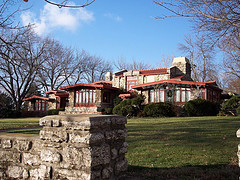

Jesse A. Hoel Residence
2108 Washington Boulevard
Louis S. Curtiss, Architect
Built 1915-16
The Jesse Hoel house is one of the finest works of architecture in Kansas City, Kansas. Its owner was obviously a man of progresssive ideas in planning and architecture. When Hoel, Fife and Hanford L. Kerr began the subdivision of the Kerr estate into Westheight Manor in 1915, they began what was for the time and place a very advanced development. The firm of Hare and Hare was engaged as planners and landscape architects, and Louis Curtiss was chosen as the architect for Hoel's new house facing the major intersection at the heart of the development.
Completed in 1916, the house was stylistically the most advanced of Curtiss' works. In recent years many people of the area have mistakenly believed it to be the work of Frank Lloyd Wright. Its relation to the work of Wright and the Prairie School is more one of spirit and principle than of form, however. Very low and horizontal, the rough stonework seems to grow naturally out of the site in a series of low terraces, with the boundary wall adjacent to the street defining the first slight increase in elevation. Each major interior space is expressed as a distinct volume on the exterior, the whole interlocked into an asymmetrically balanced composition. The roofs are of varying pitch, all low, and with overhanging eaves to further emphasize the horizontality with their deep shadow lines. The glass areas are extensive, the use of casement windows and French doors serving to integrate the interior with the outdoors. The roof lines and the use of tile, the trellises, planting boxes, and the detailing of the woodwork all impart an oriental feeling, a feeling emphasized by the painting of all such exterior woodwork Chinese red.
The house is in excellent condition with only some iron grillwork of questionable origin. Certain changes and additions were made in the early 1950s, but handled so sensitively as to make it difficult to determine what is and what is not original. It seems to have become one with its site as the various plantings have grown up over the years and the stonework has weathered to the appearance of natural outcrops. In this, as in its clear expression of function, it remains one of the finest examples of the Progressive Movement in architecture to be constructed outside of Chicago or Pasadena.